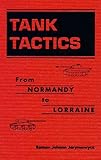Tank Tactics : From Normandy to Lorraine / Roman Johann Jarymowycz.
Material type: TextSeries: The Art of WarPublisher: Boulder : Lynne Rienner Publishers, [2023]Copyright date: ©2001Description: 1 online resource (363 p.)Content type:
TextSeries: The Art of WarPublisher: Boulder : Lynne Rienner Publishers, [2023]Copyright date: ©2001Description: 1 online resource (363 p.)Content type: - 9781555879501
- 9781685852085
- online - DeGruyter
| Item type | Current library | Call number | URL | Status | Notes | Barcode | |
|---|---|---|---|---|---|---|---|
 eBook
eBook
|
Biblioteca "Angelicum" Pont. Univ. S.Tommaso d'Aquino Nuvola online | online - DeGruyter (Browse shelf(Opens below)) | Online access | Not for loan (Accesso limitato) | Accesso per gli utenti autorizzati / Access for authorized users | (dgr)9781685852085 |
Frontmatter -- Contents -- Foreword -- Acknowledgments -- Introduction -- 1 Cavalry and Mechanization, 1918-1930 -- 2 North American Tank Forces -- 3 Creating a North American Armored Force: The European Influence -- 4 Armor's Genesis in North America: The United States and Canada Create Armored Forces -- 5 Creating North American Panzer Armies: Lessons from Europe and Africa -- 6 Allied Strategic Offensives in Normandy: Operation Goodwood -- 7 Operation Spring, 25 July 1944: The Other Cobra -- 8 Operation Cobra: Bradley Acquires Operational Maneuver -- 9 Breaking Out: Operation Totalize, 8 August 1944 -- 10 Strategic Breakout: Operation Tractable -- 11 Armor in Its "Proper Role": The Pursuit Doctrine -- 12 Patton's Lieutenants in Lorraine: A Maturation of Maneuver Warfare -- 13 "Who Killed Tiger?": The Great Tank Scandal -- 14 Stavka in Normandy -- 15 Conclusion: The Allied Operational Art -- Appendix A: Allied Tanks of World War I -- Appendix B: Allied Armored Formations, ETO -- Appendix C: The M4 Sherman Tank -- Appendix D: Armored Corps Casualties -- Appendix E: Sample of Allied Tank Casualties by Theater -- Appendix F: Tiger Versus Allied Armor: Penetration Tables -- Appendix G: Analysis of Allied Tank Casualties in Normandy, 6 June—10 July -- Selected Bibliography -- Index -- About the Book
restricted access online access with authorization star
http://purl.org/coar/access_right/c_16ec
An operational critique of the art of war as practiced by U.S. and Canadian tank commanders in France in 1944, Tank Tactics also traces the evolution of North American armored doctrine. Jarymowycz draws on after-action reports, extensive battlefield reconnaissance (involving both Allied and German veterans), and recently discovered battle performance reviews, as well as on Allied and German interrogation reports, war diaries, and technical evaluations, to compare and evaluate combat success and failure. He provides detailed tactical diagrams and analyses of tank vs. tank engagements—and illustrates the frustrations of commanders attempting maneuver warfare under the exasperating caution of Bradley and the questionable direction of Montgomery. This penetrating analysis features a review of tank battles in Lorraine, where 3rd Army commanders demonstrated mastery of Mission Command doctrine. Jarymowycz concludes by comparing U.S. and Soviet approaches to operational maneuver, describing creative tactical mixes found in combat commands well before battlegroups became common NATO parlance.
Mode of access: Internet via World Wide Web.
In English.
Description based on online resource; title from PDF title page (publisher's Web site, viewed 02. Mai 2023)


